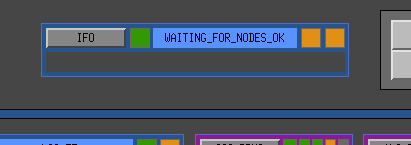Jenne, Sheila, Evan
We locked at 10Watts with low noise, and redid the OMC excitations that Koji and I did in alog 17919. We plotted the OMC L excitation against a model with a peak to peak motion of 36 um, and the result seems consistent with a reflectivity of 160e-7 that we measured on Friday by exciting the ISI. This is slightly worse than what we measured in April.
We made these excitations with the same amplitudes and frequencies that we used in April, but some of the velocities seem to be smaller. Jenne is working on doing a more thourough comparision, but it seems that the scatter is better when we are exciting Yaw and Transverse, if a little worse for longitudnal.
We used a frequency of 0.2 Hz for all excitations.
| DOF | excitation amplitude (0.2Hz) | time | Ref |
| OMC L | 20000 | 4:39:30 | 10 |
| T | 20000 | 4:43:51-4:47:00 | 11 |
| V | 20000 | 4:47:30-4:49:20 | 12 |
| P | 2000 | 4:51:38-4:53:20 | 13 |
| Y | 200 | 4:54:00-4:56:20 | 14 |
| R | 2000 | 4:56:47-4:58:00 | 15 |
I'm concerned that the times from the April data for the Longitudinal excitation that Sheila is using aren't quite correct. This means that for the "L" traces we're integrating some "no excitation" time in with our "excitation" time, and using this muddled spectra as the measurement of the OMC scattering.
I have pulled the data from April, and adjusted the start time of each measurement to ensure that the excitation channel was fully on at the start (the [0][0] "time series" trace in DTT), and was still fully on for the last average (the [0][9] "time series" trace). Since I only had to adjust the "L" start time, I think this is the only one that is affected. With this adjustment, I see that the knee frequency goes down for L and T. It stays about the same for P, and is hard to tell (almost no scattering) for Y. The amplitude is a little bit higher for L and P, but not by a lot. Since the knee frequency is directly proportional to the velocity (eq. 4.16, Tobin's thesis), this seems to imply that even though we were actuating with the same amplitude and frequency, the true motion is slower now than in April. Is this because we are also pushing around the weight of the glass shroud? I'm not sure how the glass is mounted.
The times that I'm using are as follows:
| 16-17 April 2015 (t0 UTC) | 14 July 2015 (t0 UTC) | |
| No excitation | 23:33:39 | 04:49:57 |
| L excitation | 23:47:47 | 04:39:30 |
| T excitation | 23:59:00 | 04:43:56 |
| Y excitation | 00:31:00 | 04:55:00 |
| P excitation | 00:24:00 | 04:51:50 |
Another thing to add:
Since June 25 (right after shroud thing was done) and including the time this measurement was done, OMCR beam diverter has been open and nobody cared to close it.
Though it's not clear if this makes any difference, any comparison should be done with the diverter closed.
Regarding Jenne's comment above, "Is this because we are also pushing around the weight of the glass shroud? I'm not sure how the glass is mounted." - the black glass shroud is mounted to the OMC structure, not the suspended mass. After installation, the ISI was rebalanced and retested.
















